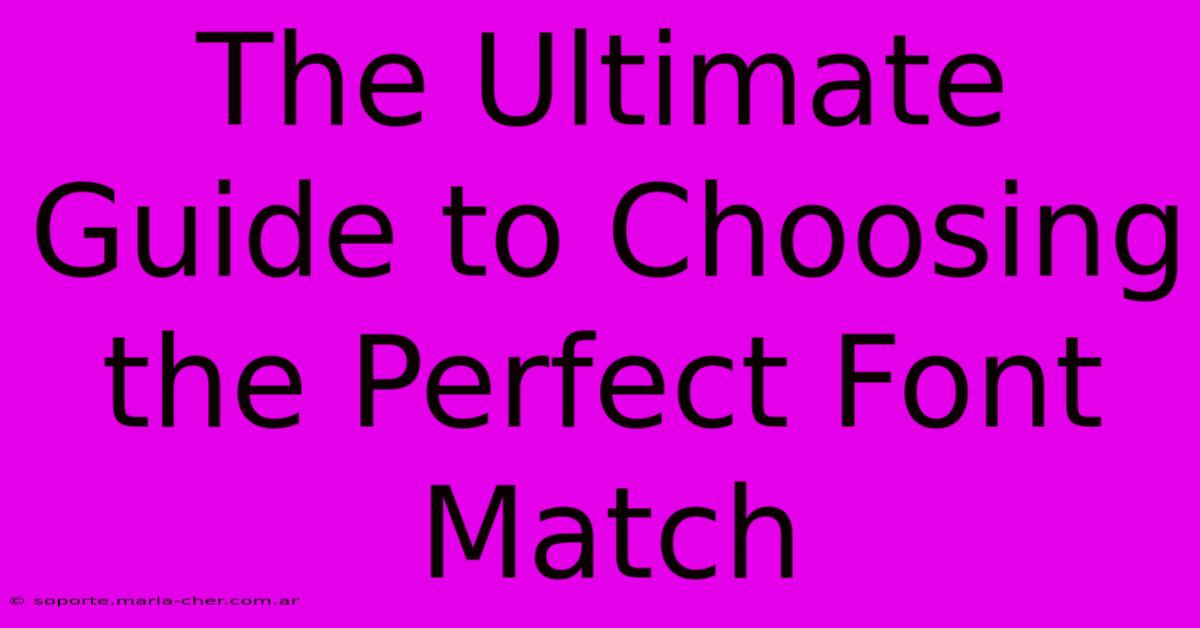The Ultimate Guide To Choosing The Perfect Font Match

Table of Contents
The Ultimate Guide to Choosing the Perfect Font Match
Choosing the right font pairing can make or break your design. A harmonious font combination enhances readability and elevates your aesthetic, while a clashing pairing can leave your audience feeling disoriented and frustrated. This ultimate guide will walk you through the process of selecting the perfect font match for any project, from websites and logos to brochures and posters.
Understanding Font Families and Classifications
Before diving into pairings, let's grasp the basics. Fonts are categorized into families based on their design characteristics. Knowing these categories will help you make informed decisions.
Serif Fonts:
- Characteristics: These fonts have small decorative strokes (serifs) at the ends of their letters. They often convey a sense of tradition, elegance, and sophistication. Think Times New Roman, Garamond, or Georgia.
- Best Use: Body text, formal documents, books.
Sans-Serif Fonts:
- Characteristics: These fonts lack the decorative strokes, appearing cleaner and more modern. They are often used for headings, titles, and online content. Examples include Arial, Helvetica, and Open Sans.
- Best Use: Headings, subheadings, website text, contemporary designs.
Script Fonts:
- Characteristics: These fonts mimic handwriting styles, offering a personal and elegant touch. They're best used sparingly. Examples include Edwardian Script ITC and Pacifico.
- Best Use: Logos, invitations, watermarks (use sparingly).
Display Fonts:
- Characteristics: Bold and attention-grabbing, these fonts are not ideal for large amounts of text but excel at making a statement. Examples include Impact, Bebas Neue, and Lobster.
- Best Use: Headlines, titles, short phrases.
Monospace Fonts:
- Characteristics: All characters have the same width, often used for coding and programming. Examples include Courier New and Consolas.
- Best Use: Code, tables, technical documents.
Creating Harmonious Font Pairings: Key Principles
The key to successful font pairing lies in understanding contrast and harmony. Here are some effective strategies:
1. Contrast in Weight and Style:
Combine a serif and sans-serif font for a classic yet modern look. Pair a bold headline font with a lighter body font for optimal readability. This creates visual hierarchy and guides the reader's eye. Example: Playfair Display (serif) with Open Sans (sans-serif).
2. Similar Styles but Different Weights:
Use fonts from the same family, but vary the weight (light, regular, bold). This creates a cohesive yet diverse look. Example: Different weights of Montserrat (light, regular, bold).
3. X-Height Considerations:
X-height refers to the height of lowercase letters. Fonts with similar x-heights improve readability when paired together. Avoid pairing fonts with drastically different x-heights.
4. Consider the Context:
The ideal font pairing depends heavily on the project. A playful script font might work well for a wedding invitation but would be inappropriate for a legal document.
5. Test and Iterate:
Don't be afraid to experiment! Try different combinations and see how they look in your design. Use online font pairing tools to get inspiration and play around with different options.
Common Font Pairing Mistakes to Avoid:
- Pairing too many fonts: Stick to a maximum of two or three fonts to avoid visual clutter.
- Using fonts that are too similar: This can lead to a monotonous and uninspired design.
- Ignoring readability: Prioritize readability over aesthetics. Ensure sufficient contrast between the font colors and the background.
- Overusing decorative fonts: Script and display fonts should be used sparingly.
Resources and Tools:
Several online resources can assist in finding the perfect font pairing:
- Google Fonts: A vast library of free, open-source fonts.
- Adobe Fonts: A comprehensive collection of fonts for Adobe Creative Cloud users.
- FontPair: An online tool that suggests font pairings.
By following these guidelines, you'll be well-equipped to choose font combinations that enhance your designs and leave a lasting impression on your audience. Remember, practice makes perfect! Experiment, iterate, and refine your approach to discover your signature font pairings.

Thank you for visiting our website wich cover about The Ultimate Guide To Choosing The Perfect Font Match. We hope the information provided has been useful to you. Feel free to contact us if you have any questions or need further assistance. See you next time and dont miss to bookmark.
Featured Posts
-
The Royal Touch Elevate Your Everyday With A Fleur De Lis Necklace
Feb 10, 2025
-
Slay The Style Game D And D Nail Colors That Strike True
Feb 10, 2025
-
Uncover The Hidden Treasure Trove Finding Your Email Subscriptions Made Easy
Feb 10, 2025
-
Say Goodbye To Clutter Corner Living Room Ideas For A Tidy And Inviting Home
Feb 10, 2025
-
Unveiling The Power Of White Space How Less Can Be More In Your Life
Feb 10, 2025
